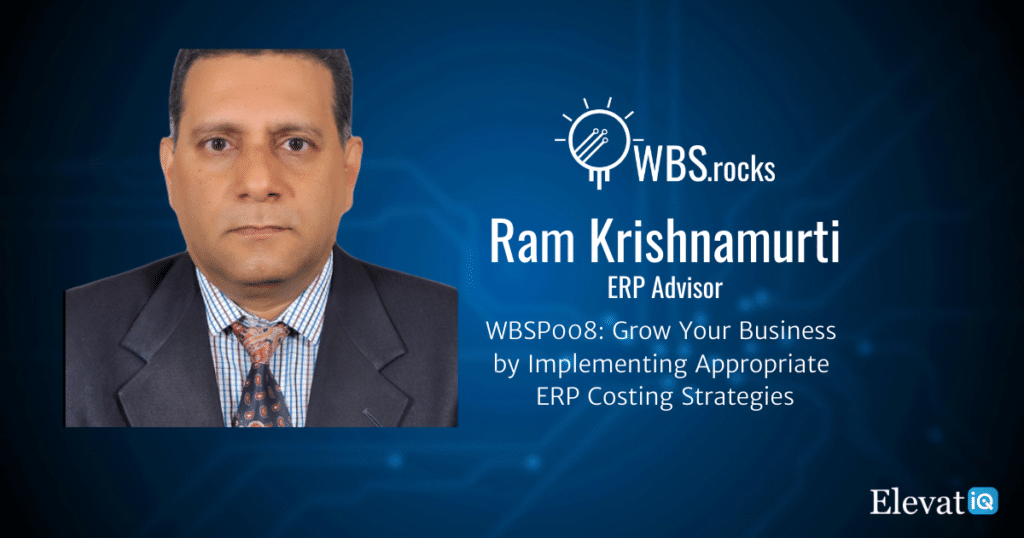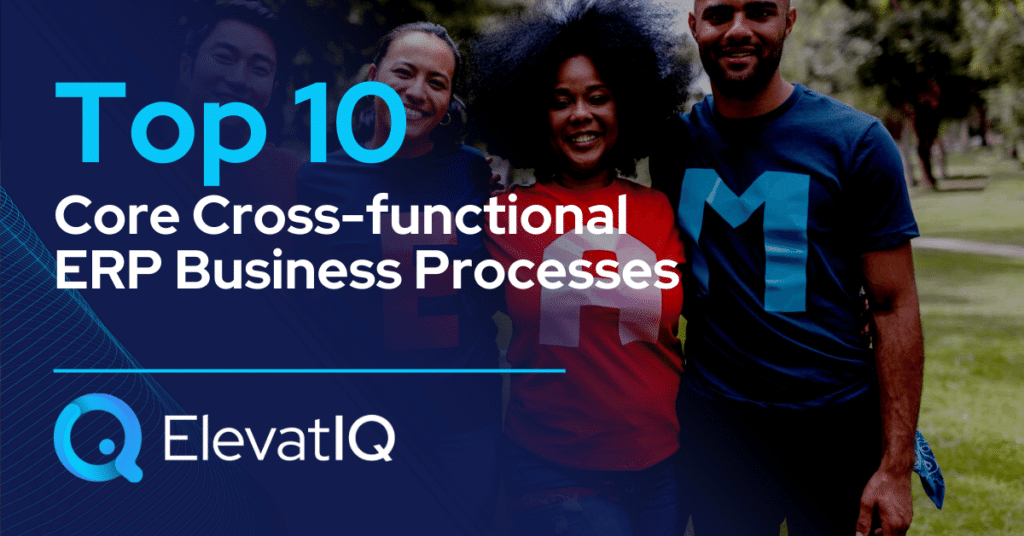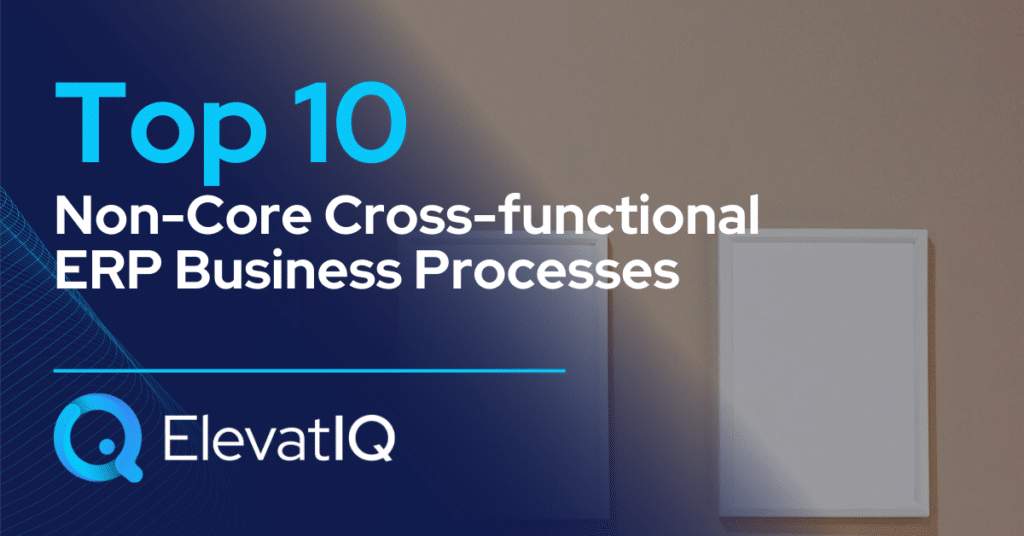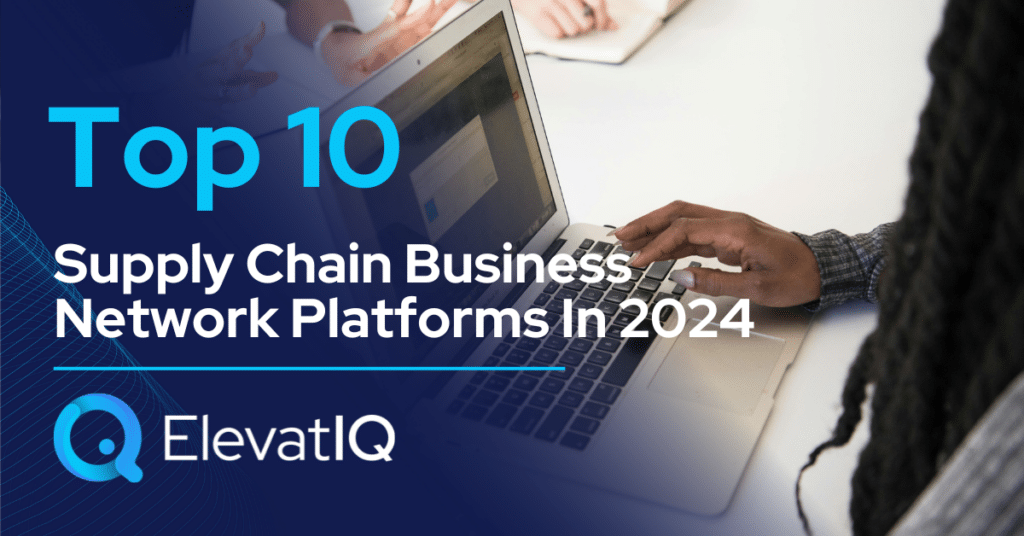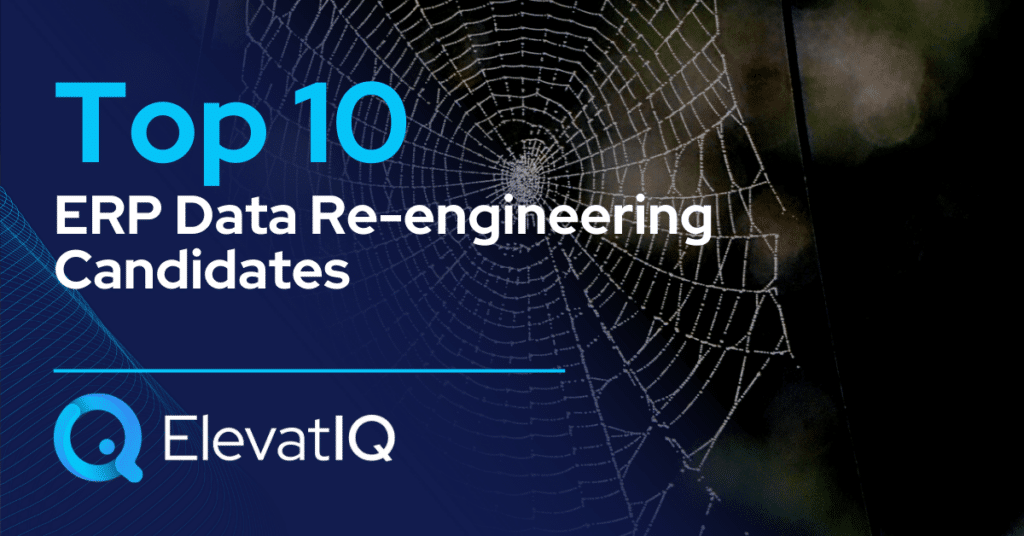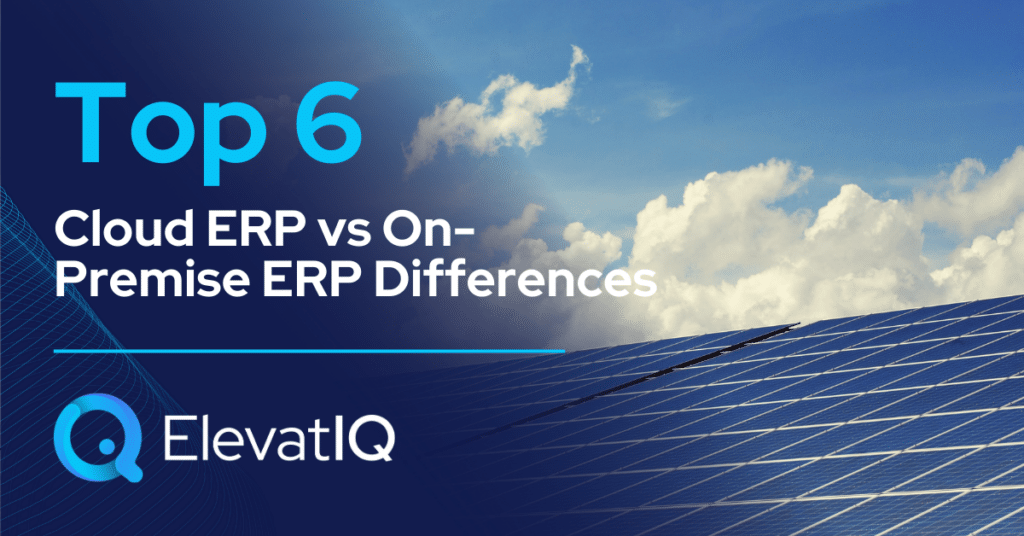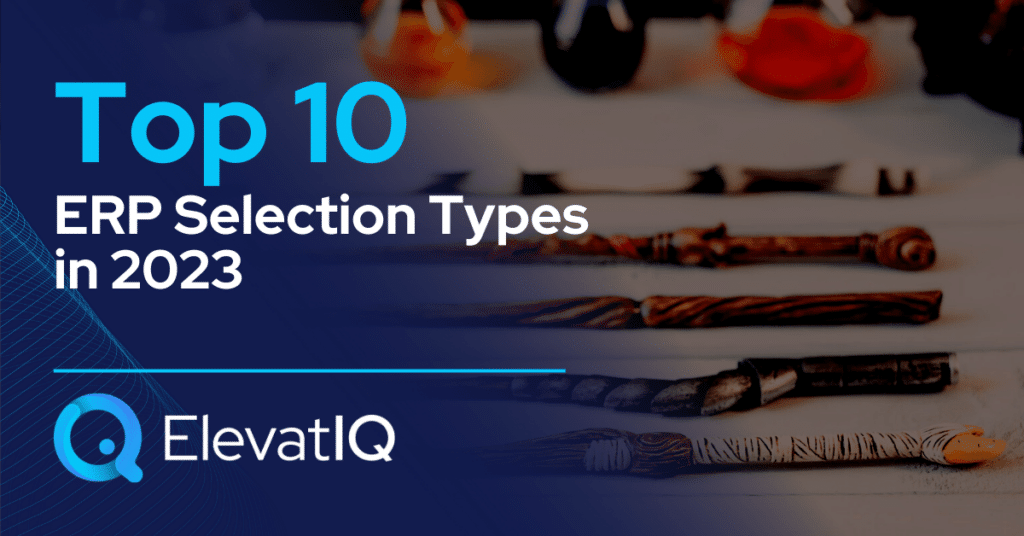In this episode, we have our guest Ram Krishnamurti, who discusses costing strategies for different businesses and why that matters for ERP implementations. He also breaks down some of the ERP concepts for executives who may not be familiar with ERP or ERP implementations.
Finally, he shares some secrets into what makes ERP transformation projects successful and who would be the right fit to consider an ERP if they have never had one.
Chapter Markers
- [0:00] Intro
- [2:48] Personal journey and current focus
- [4:41] Perspective on growth
- [7:27] What is an ERP system?
- [12:21] Which companies are the right fit for an ERP?
- [14:26] Implications of having these duplicate records across the systems
- [19:01] Why is costing important for manufacturers?
- [23:49] Different costing methods and their implications
- [30:20] Closing thoughts
- [31:20] Outro
Key Takeaways
- An effective ERP implementation will force you to look at these inefficiencies.
- Over the last 10 years, ERP technology has also changed and the cloud has come in a big way.
- A perfectly properly implemented ERP can give you data and insights that you never expected to see.
- ERP helps you to focus. It helps you to do focus less on your back end process and focus more on your operations and the sales and the marketing part.
- Disparate applications having different views of the same base data is a major challenge, which you will be facing if you are a disparate set of disparate systems running your organization.
- In commodity industries, weighted averaging will not work. For these industries, you need to have a different costing method, which is called batch costing, or lot costing. That is somewhere between specific costing and FIFO. It’s also an averaging method. But you’re averaging cost at a lot level.
- In most of the other industries, especially manufacturing, the weighted averaging cost will work fine. Either a transaction weighted averaging as in discrete. Or a batch weighted averaging as, as in process industry.
- Standard costing is very, very complex, and it has a lot of P&L impact.

Subscribe and Review
Apple | Spotify | Stitcher | Google Podcasts | Deezer | Player FM | Castbox
About Ram
Ramaswamy Krishnamurti (Ram) is a Passionate ERP Project Manager and Solution Architect with over 32 Years of the overall experience of which in the last 21 years he has worked in all areas of ERP Implementation starting from Product Selection, Vendor Evaluation, and Selection, Presales, Implementation, Upgrade and Support, and Stabilization. A graduate in Mechanical Engineering from Calicut University in Kerala, India, Ram did his MBA from Kolkata University and Post Graduate Diploma from the prestigious Indian Institute of Management, Bangalore.
He has implemented more than 25 highly successful ERP implementations. He has worked on Scala, Peoplesoft, Oracle EBS (11i and R12), and Oracle Fusion Cloud in various roles including CIO, Program Manager, Delivery Manager, Project Manager, Solution Architect, Functional Lead, and Consultant. One thing common among all these roles is an average customer satisfaction rating of more than 90% over his over 20 years of ERP Implementation expertise.
Ram is an expert in implementing ERP Costing Solutions for different industries including discrete and process manufacturing, Jewellery, Pharma, and FMCG industries. In his career spanning over 30 years, he has implemented different costing solutions ranging from Specific Costing, FIFO, Average Costing, and Standard Costing.
Resources
- Connect with Ram
Full Transcript
Ram Krishnamurti 0:00
An effective ERP implementation will force you to look at these inefficiencies. Your implementation could be a huge eye-opener that, oh my God, we had so much data misalignment in our organization. No wonder, we are having so many challenges and so many internal disputes.
Intro 0:16
Growing a business requires a holistic approach that extends beyond sales and marketing. This approach needs alignment among people, processes, and technologies.
So if you’re a business owner, operations, or finance leader looking to learn growth strategies from your peers and competitors, you’re tuned into the right podcast. Welcome to the WBS podcast where scalable growth using business systems is our number one priority.
Now, here is your host, Sam Gupta.
Sam Gupta 0:52
Hey everyone, welcome back to another episode of the WBS podcast. I’m Sam Gupta, your host, and principal consultant at digital transformation consulting firm, ElevatIQ.
When it comes to growth, the growth could fire back if you don’t have sufficient margins to sustain a business. If you have a busy shop floor with several variables that go into making your products, tracking your product’s cost could be critical. There are several methods of costing which could vary across industries. Choosing an appropriate costing method could drain your profitability and mislead you into making incorrect business decisions that could jeopardize your business.
In today’s episode, we have our guest Ramaswamy Krishnamurti who discusses costing strategies for different businesses. And why that matters for ERP implementations. He also breaks down some ERP concepts for executives who may not be familiar with ERP or ERP implementations. Finally, he shares some secrets into what makes ERP transformation projects successful and who would be the right fit to consider an ERP if they have never had one?
Let me introduce Ram to you.
Ram is a passionate ERP project manager and Solution Architect with over 32 years of overall experience. He has implemented more than 25 highly successful ERP projects in several roles, including CIO and consultant, with an average customer satisfaction rating of more than 90%.
Ram is an expert in implementing ERP costing solutions for different industries, including discrete and process manufacturing, jewelry, pharma, and FMCG Industries. He’s also a published author for his book Selected Articles on ERP.
With that, let’s get to the conversation.
Hey, Ram, welcome to the show.
Ram Krishnamurti 2:45
Thank you, Sam, for having me on the show.
Sam Gupta 2:48
It’s my pleasure. And I’m super excited to discuss your expertise today because you have done a ton of ERP implementations. So to start off, would you like to share your personal story and what you are focusing on these days?
Ram Krishnamurti 3:02
Sure, I have over 30 years of the overall experience. Out of that about 11 years in manufacturing. And for the last 20 years, I’ve been implementing ERP.
When I say implementing ERP, I’ve been going to the customer’s places, I’ve been doing the implementation, doing upgrades, everything relating to implementation. I’ve not been doing a lot of pre-sales or delivery management. It is the pure customer-facing implementations I’ve been doing. I’ve been doing it for the last 20 years. I have implemented end-to-end business solutions, including procurement, inventory, manufacturing, order fulfillment, financials, budgeting, and components accounting.
So I have a breadth of experience in ERP accumulated over the last 20 years. Just recently, I completed one project in Oracle Fusion Cloud. So I was the project manager and we got, you know, 100% customer satisfaction for that project.
I do a lot of blogging. I am very active on LinkedIn, I offer free training, and sharing my knowledge with a lot of, you know, consultants were up and coming. So, so far done over three sessions. And all of them have been quite well received.
And presently, I’m also focusing on new technology because I believe that this coming decade, the decade of the 20s is going to be that of technology. So there are about 20 technology themes and ideas that are going to drive the technology agenda for the coming decade, coming 20 years. A multi-decade of changes is going to happen in technologies. I’m trying to learn a little bit about all these new technologies and at the same time blogging about them.
Sam Gupta 4:41
Okay, so since this is the growth podcast, and this is the question that I ask everybody Ram. Tell me what is your perspective on growth as far as the small to medium-sized businesses go?
Ram Krishnamurti 4:52
That’s a very interesting question. Most of the small to medium-sized companies are still hesitant to go on ERP, they still think that the ERP, some esoteric product, which you know they won’t be able to handle on their own probably. And they don’t ERP see right now what we are seeing is technology has moved beyond the ERP. But even now we see many other small and medium segments that hesitating to move to ERP.
But over the last 10 years, ERP technology has also changed and the cloud has come in a big way. ERP implementation in case you want to move to your ERP. It is much more noninvasive than you know it was earlier a bit on-premise. You have to have a lot of investment and all that, a whole lot of changes have happened.
And then you talk of growth in a growing company that needs a good ERP backbone. That is my perspective. But having said that, I understand there’s a lot of hesitation because they also see a lot of challenges in implementing.
Ram Krishnamurti 5:58
But that’s where good consultants and implementation partners come in. They can bring a lot of value to the organization. And a perfectly properly implemented ERP can give you data and insights that you never expected to see.
For example, when ERP was implemented for a company I worked for, they found that in one of the processes. It’s again just one process. They were able to get a huge amount of monthly savings. And this information was available to them only because of the digital ERP. They would never have known that such inefficiencies existed.
So ERP helps you on an obvious scale. When you are going to scale up as a part of your growth, you need ERP support. ERP helps you to focus. It helps you to do focus less on your back-end process and focus more on your operations and the sales and the marketing part.
So a good ERP automatically is like Google Assistant. It takes care of the back-office operations so that you are free to focus on your business growth activities. So that’s the main area where the ERP helps. In summary, it is my considered opinion as an ERP consultant that going forward for growth to accelerate the traditional approach to IT will not work. You need to have a transformative approach. And your ERP has to be the backbone of that transformative approach.
Sam Gupta 7:27
Okay, so obviously, you know, some of our listeners are going to be extremely familiar with ERP systems just because they might be slightly bigger in size. The smaller-sized businesses might not be as familiar with that.
In fact, there is varying opinion in terms of what an ERP is. Some people think that it is an accounting system. For some people, it is the MRP system. For some people, it is an order management system. So in your opinion, what is an ERP system and I know you have touched on the benefits of the ERP system, but let’s say if I’m trying to explore an ERP, how would you describe an ERP to me and for my company?
Ram Krishnamurti 8:11
Sure, if you look at a traditional organization, it has different departments which are running silos of operation. I’m sure that every one of your customers would have heard the term silos of operation at some time or other, but silos of operation are a real thing.
You know, you have procurement departments sitting in one location, stores in another location, finance, and accounting in another location. And they don’t talk to each other. For example, the purchasing department raises a purchase order and then sends it to the finance department and a copy will go to the stores’ department. But the store’s department will not have a back communication to a procurement saying that as we have received your document. And then once the material is received, the procurement department will not get any information that the material has been received and everything is perfect.
Ram Krishnamurti 9:00
So that you know you can negotiate with the vendor, ask him to send the invoice. Whatever so this communication is not there. Due to the lack of this communication between various departments, there is inefficiency in the entire process of your organization. There is an increase in vendor disputes. Vendors will talk to different agents. The vendor will talk to the procurement department. Some other contact vendors will talk to the store department. Some third guy will talk to the accounts department.
So, there is no integration in either communication, or in processes, and even in systems. Many organizations will have some systems, maybe Excel, maybe some other system, which, they will be using for each of these processes.
Each of these systems will also be you know, disparate. Like you have an accounting system. You have a procurement system. You have a warehouse management system. So these are all disparate systems you will have in your organization and the disparate system will clog your data. Because they may have the same vendor may exist in both the finance and accounting system as well as in your procurement system.
Ram Krishnamurti 10:07
So there is data duplication. There are multiple sources of truth. And all these things cause inefficiency in your organization. And what do you need to overcome this? You need a single application, which will integrate your entire processes, which will act as a single source of truth, which will give you overall visibility into your processes, end to end process, starting from the requisitions, all the way up to your GL and the financial reports and cash flow statements.
So this if you have this application, it is a single solution for your entire business operations. And that is obvious if you have multiple systems and you’re struggling with it, you can easily visualize your customers can easily visualize the benefit of a single system, a single integrated system with a single source of truth. You imagine the number of disputes that will come down within your organization. There will not be the fights between procurement store and finance will come down across the organization and with your partners. Vendor disputes will come down. Customer disputes will come down. So entire process efficiency will have a jump start with an ERP system.
Ram Krishnamurti 11:22
So if any of your customers are still thinking that they want an ERP system, my answer is unequivocal. Yes, they need, they will need an ERP system, especially if they’re in the manufacturing area. I’m not talking here about any specific system per se. You need a well-configured ERP system to run your business.
That is you know, at this point in time, that is like having a mobile phone. Everybody has a mobile phone. So every company should have an ERP system. It’s not any longer a luxury. It is more of a necessity and a need for efficient operations these days. So that will be my response to your customer who says that I don’t know your ERP. So in summary, ERP helps you integrate your processes, replace disparate applications within a single application and improve your end-to-end process efficiency and visibility.
Sam Gupta 12:21
Okay, you just mentioned that ERP is going to be like having a mobile phone, which is great, but do you believe that every company out there, irrespective of how large or small they are needs to have an ERP?
Ram Krishnamurti 12:35
Yes, 10 years ago or, you know, five years ago, if you asked me this question, I would have said maybe. Yes. No. I would have been iffy, but now I am not iffy. I’m saying that technology has moved further much further ahead.
So now, ERP is no longer an esoteric technology. ERP is one of your you know basic necessities for any organization whatever is the business they are in. You will need an ERP. Data is a key you know in this in these times and data visibility data intelligence data analysis, taking out useable information from the data.
These are all the focus of the companies that focus on the companies should shift from Okay, whether my work order has been created properly, whether my MRP is running properly, or whether materials are coming properly; whether my vendor is supplying me material properly to my stores; whether my quality checking is happening properly. These are all no longer your focus area because ERP will handle all these things.
Ram Krishnamurti 13:42
And ERP will give you beautiful dashboards and information which will tell you whether everything is going fine. And then ERP will also give you exception reports in some of the areas where things are moving towards some issue.
So predictive exception reports also your ERP can give, a well-configured ERP. So ERP is if necessary. The caveat here is ERP has to be implemented with and some of the customers who are hesitant about the ERP have also seen that almost 60 to 70% of ERP failed to complete implementations. I mean, failed to deliver the expected return on investment in the expected time period. So that is where they are becoming hesitant I think.
Sam Gupta 14:26
Okay, so I want to dig a little bit deeper into one of the comments that you made related to the vendors existing in different systems. So if I look at the SMB landscape, vendors or customers existing in different systems. Let’s say if I have disparate architecture, I am going to have multiple systems in my organization, especially in these small to medium-sized businesses.
So I may have let’s say QuickBooks for accounting. I may have Salesforce for CRM. I may have a procurement system that could be Coupa or Ariba, something like that. Then there might be some other systems that say if I’m a project organization, I may have a tool called Mavenlink, or something similar.
So typically, when we work with newer organizations or smaller organizations, they like to use multiple tools. When they use these multiple tools, they need to have the customers or vendors, and each of these systems. If you look at Salesforce, Salesforce requires the customer data to be able to make the transactions inside Salesforce from the sales perspective.
If you look at QuickBooks, QuickBooks will require vendor and customer data from the accounting and finance perspective. So in your opinion, what would be the implications of having these duplicate records across the systems? Can you touch on that?
Ram Krishnamurti 15:47
Sure, I can do that by referencing one of our implementations. They had a separate procurement management system. So the procurement management system has its own vendor definition. Then we went to implement ERP for ERP procurement, you need to have the vendor definition.
We felt that that was not a big company, which could, there are applications like Master Data Management System which can handle such a situation. But it was not a big company, which could invest at that point in time in a data management system.
So what we did is we looked at the processes we so here are, one option was to duplicate all the vendors in the ERP system, but then that will create two sources of truth with two different people managing the vendor data and ensuring that the vendor information was in sync in both the application was a major challenge. So that was one of the challenges.
Ram Krishnamurti 16:43
So to answer your question, if you’re having a disparate system, that’s what I mentioned about the single source of truth earlier. If you have a disparate system, multiple sources of truth are bound to be an issue, because for example, if you take as your example of QuickBooks, having vendor information as well as a procurement system having vendor information.
So it is possible that the accountant who creates a vendor in QuickBooks will create the account does account to clear the vendor has said john smith, in the procurement management system. The same entry may be created as Smith, John, or it may be Mr. john smith. So these small tweaks can totally change the way these two systems talk to each other.
So you will find that in the procurement system, there is a purchase order it is “Mr. Smith, John”, whereas, in your QuickBooks, there is no information about “Smith, John”. So this kind of these, these are not small issues, you know. I have faced such vendor naming challenges, even in the existing system, it’s a vendor gathered, then I’m going to implement and when they give me fewer vendor data, I invariably see the situation the same “John Smith”, “Mr. John Smith”, “Smith, John.”
Ram Krishnamurti 17:57
So there are multiple variants of the same end up with transactions. One of the major challenges, when I go to implement ERP, is merging these vendors and ensuring that all the disparate applications as synchronous data. So disparate applications having different views of the same base data is a major challenge, which you will be facing if you are a disparate set of disparate systems running your organization.
And that’s where the ERP comes in handy. One major benefit of your ERP implementation is not implementation per se. And effectively our ERP implementation will force you to look at these inefficiencies. Sometimes your implementation could be a huge eye-opener that Oh my God, we had so much data misalignment in our organizations. No wonder we are having so many challenges and so many internal disputes.
So this vision that we are inefficient processes that itself is a major, major gain if you start going on your ERP implementation process.
Sam Gupta 19:01
Okay, amazing insight there, I love those examples, to be honest. So now we are going to shift the gears a bit and obviously, we need to talk about your costing experience. You have done a ton of implementations, as you mentioned in your introduction. So we want to make sure we are digging enough into the costing because some of the manufacturing customers when we work with them are extremely savvy with respect to the way they do the product costing the way they compute their profit margins.
But other manufacturers if I am going for some of the hand assembly shops, they don’t really know how much their product really costs. So can you touch on what costing is from your perspective? How would you describe this to a small business?
Ram Krishnamurti 19:49
Okay, that’s a good question. When you talk of costing, you know you have to look at it from two different perspectives. The costing is essentially we are talking about the tracking and analysis of the procurement you know. You procure different raw materials. And you want to track and analyze the performance of the procurement department. And the best way to do that is to use the cost and the training cost as a parameter to evaluate the performance of the procurement department. So there is costing from a raw materials perspective.
But then there’s another perspective costing is generated in the procurement department. But most organizations use the cost as you mentioned as a cost-plus markup pricing system or as a method of evaluating their profitability. So in that case, they’re looking at the cost of the finished product. So when you talk of costing, so, you have the cost which is created in the procurement department, but which is used in your production, as well as in the sales and the cost of goods sold as well in the finance department.
Ram Krishnamurti 20:56
So costing as these two different implications, you know, one is on the creation part, and one is on the cost consumption if I could use that word, the cost consumption in the finished goods costing part. So it’s very important to understand these differences because, in some organization, your focus will be on the procurement part, especially if you are bulk discounts and payment rebates, all those situations in those situations you are focused on how to improve my procurement so that I can get the benefit of all these cost benefits through my procurement department.
Another aspect is like I mentioned from the pricing perspective. So the benefit of ERP is that it will give you the information in both ways. You can get costing information and the tracking information, and details from the procurement when it comes to the raw material. You can also give detailed cost information about your finished project product, which you can use to analyze and evaluate to see how my cost is evolving over a period of time and is it in line with inflation or am I having some challenges in my cost is there any specific element which is going high or which is going low or whatever.
Ram Krishnamurti 22:05
And also, once you have confidence in your cost of the finished product, you are all your decision making the quality of your decision making, including pricing, including profitability analysis, even in the salesperson email, the available to promise level, your quality of decision making will improve the transparency of your finished product cost.
So look at your cost from both sides cost is generated during your procurement and the resource consumption. And the most in finished products that cost is a use cost is finished products are cost users rather than cost creators. So if you have this vision, that cost has two aspects. One is the creation aspect. And the other is the utilization aspect, and your decision-making will open up significantly.
Right now, there’s a lot of confusion even in a lot of customers who might deal with also this confusion about the definition of cost. Just another day, I was actually talking to one friend of mine who has worked in costing his entire life. He has 24 years of experience in costing but I asked him how do you do the costing of your raw material without ERP. And he was confused as to how we are doing it, how we were doing it.
Ultimately, he had to go back and check and then come back to me saying that, okay, this is a process that we were following, you know, prior to our year. So and this gentleman who has over 20 years of experience in costing is a cost accountant of that company. So this kind of confusion when it comes to costing is a lot of times. It’s a norm rather than the exception in many other companies, whether it is a big company, whether it is a small company, this confusion I’ve seen happen in many of the customers.
Sam Gupta 23:49
Okay, would you like to touch a little bit about different costing methods available for this and what are going to be the implications if you don’t choose the right costing method designed for your business model?
Ram Krishnamurti 24:02
Sure, it is a terminology that I have coined. It’s called. I call it costing continuum. It has specific costing on one end and standard costing on the other end. Specific costing obviously means that each unit of item has its accurate cost. Standard costing on the other end of the continuum none of the units is that accurate cost as generated from the transactions.
So in between this continuum you have different methods fee for then you have weighted average costing and then you have some other methods which are not generally used and then comes to standard costing. So mostly these four costing methods, specific costing fee for weighted average cost and standard costing. These are the four costing methods.
Now you know if you look at the first three and standard costing, you will see a classic difference here. If you look at either of the three specific costing FIFO or weighted averaging, it is just a cost capturing method.
Ram Krishnamurti 24:59
So if you buy an item for 10 rupees, the cost is 10. If you buy another item same item for 20 rupees, the average cost becomes 15. So it is just a cost capturing averaging process these product-specific costing, which is very rarely used FIFO as soon as we get a very nice by the name itself, it’s an averaging method.
On the other end, if you see standard costing, standard costing is what you expect the cost to be customer will expect some costs based on his experience and expertise and he will want to plan and control the cost and control the differences between your actual cost as well as a standard to see where the performance is lagging or improving.
So, if your objective is to control, you must use standard costing. If your objective is capture, for example, we discussed cost plus markup asset pricing strategy. In that situation, you don’t need a lot of control, you just need to capture cost accurately.
If that is your objective, then you should go for any of the averaging methodologies, but if you’re a stable company and if your input prices are generally stable, then you may want to control my costs to see how my performance is changing with respect to cost in that case, you may want to go for standard costing.
So, these are the four different methods of costing and in general there you will use your objective capture use any of the averaging methods if your objective is analysis and control use standard costing. So this is where at a broader level, we can talk about the cost.
Sam Gupta 26:35
Okay, so when we look at different methods, do you have any recommendation to any specific business or product type where you would recommend the FIFO or the average costing?
Ram Krishnamurti 26:45
Yes, see, average costing is the default. It is going to be, my, it’s my understanding, that average cost is going to be the norm people. Or companies are not doing average costing because average costing you need ERP support. But with ERP going to becoming much more widespread average costing is going to be the either no earlier FIFO was used in situations where you know in FMCG industries where there is low shelf life products moves very fast from your shelf.
So, in that case, companies were using FIFO cost, but over a period of time with the weighted averaging coming in many other companies are going to go for weighted averaging. But having said that, there are certain industries where weighted averaging did not work.
For example, in most commodity industries, weighted averaging will not work in commodity industries because, for example, Agri products like spices. I had one customer in the spice business. So in spices, normally the market, the Spice Market is seasonal. You know, in the summer season, spices are available, and the cost is very cheaper. And in the rainy season, the spices are less available, and it’s much more expensive.
Ram Krishnamurti 27:56
So what the companies will do is they’ll buy a bulk of their procurement chili, for example. They will buy the bulk of their Chili during the summer season as their availability is high and the cost is low.
Now, in this scenario, assume that you buy some lot in winter and if you’re using a weighted averaging scenario, what is going to happen to the average cost of the entire quantity is going to change. Now, the operation manager will not accept this because then their organization put in a lot of effort to identify a good source of you know, chili in summer at a lower cost. And just because a fancy ERP system has come in and done a weighted averaging. Now my entire cost has gone for a toss. And my profitability has gone for a toss.
So, this is applicable to every commodity industry, whether you’re taking of oil, whether you talk of sugar, whether you talk of steel, whether you talk of agri product. In any commodity industry, weighted averaging will not work.
So you need to have a different, you know, costing method called batch costing or lot costing. That is somewhere between specific costing and FIFO. So, it’s also an averaging method, but you’re averaging cost at a lot level.
Ram Krishnamurti 29:12
So, you can cost at a summer lot. You can cost at a winter lot. So, the costs are different. Your profitability information is much more accurate from the perspective of business in the case of those costing methods.
So, the commodity industry is mostly cannot do averaging. Weighted averaging is not acceptable for commodity industries. But most of the other industries manufacturing especially I think weighted averaging cost either it’s a transaction weighted averaging as in discrete. Or a periodic weighted averaging as, as in the process industry, I think that will work pretty fine.
Now standard costing is very, very complex. And if your audience uses a small and medium segment, standard costing has a lot of P&L impact. And if it’s not controlled properly, then the profit and loss statement could explain all your fees and your know why it has happened, what has happened. So of course, for your target audience, if it is SMB, I would say go for ERP, go for weighted average costing and you will do fine. You will get all the information that requests you to take any of the costing-related decision-making.
Sam Gupta 30:20
Okay, so that’s it for today, Ram. Thank you so much for your insight. Do you have any last-minute closing thoughts?
Ram Krishnamurti 30:26
Thank you so much for giving me this opportunity. Obviously, there are many, many more aspects to costing that, you know, we could have discussed. But if it has, you know, created a curiosity in the minds of your target audience who are hesitant about ERP. I think that the objective of my discussion was to allay those fears in the minds of the companies who want to go for ERP. And ERP can give a lot of benefits.
And from the perspective of cost, a well-run ERP can take the organization to another level of performance. So that’s, that’s my closing thoughts about you know, this topic. Thank you so much for giving me this opportunity to be a part of this podcast.
Sam Gupta 31:10
Our pleasure, Ram, it’s been insightful conversation. I really had a lot of fun discussing this with you. Thank you so much for your time and insight.
Ram Krishnamurti 31:18
Thank you so much.
Sam Gupta 31:20
I cannot thank our guests enough for coming on the show for sharing their knowledge and journey. I always pick up stuff from our guests, and hopefully, you learn something new today. If you want to learn more about Ron, please visit his blog, erp-consultancy.blogspot.com, where he regularly publishes high-quality content on topics related to ERP. He’s also active on LinkedIn. Don’t forget to check his book “Selected Articles on ERP,” which is available on Amazon. Links and more information will also be available in the show notes.
If anything in this podcast resonated with you and your business. You might want to check other related episodes including the interview with Erin Koss, CPA from Syte Consulting Group who touches on why culture is an essential ingredient in growth transformation projects such as ERP implementations. Also the interview with Wayne Sadin, who brings a unique perspective on why business processes are more important for growth than individual business systems.
Also, don’t forget to subscribe and spread the word among folks with similar backgrounds. If you have any questions or comments about the show, please review and rate us on your favorite podcasting platform or DM me on any social media channels. I’ll try my best to respond personally, and make sure you get help.
Thank you, and I hope to catch you on the next episode of the WBS podcast.
Outro 32:53
Thank you for listening to another episode of the WBS podcast. Be sure to subscribe to your favorite podcasting platform so you never miss an episode. For more information on growth strategies for SMBs using ERP and digital transformation, check out our community at wbs.rocks. We’ll see you next time.


